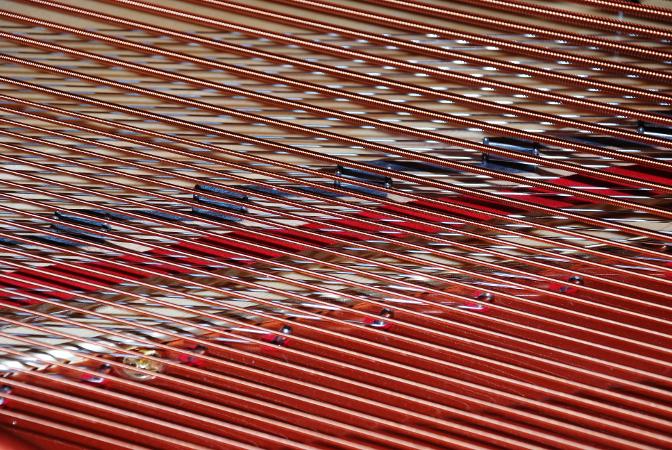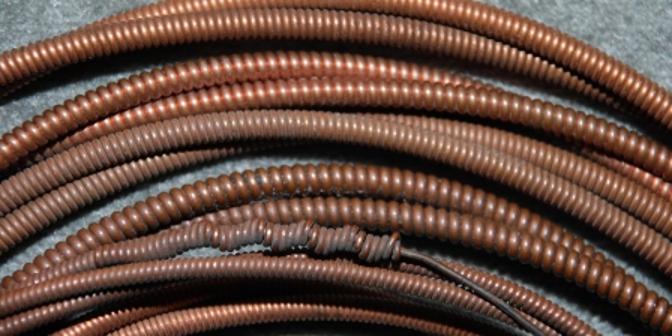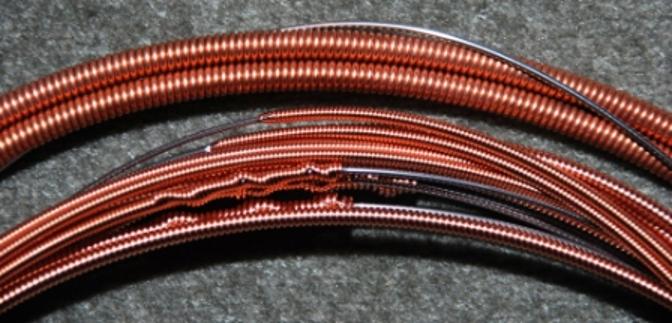Piano Tuner in Inverclyde, Renfrewshire, Glasgow, the west of Scotland and beyond.
Mozart Sonata 11 Alla Turca.mp3
Piano Strings and Stringing

THE MYTH OF RE-STRINGING:
Is it time my piano was re-strung? Would re-stringing make a big difference to the sound of my piano?
Pianos are not guitars!
It seems that people tend to think of piano strings in terms of guitar strings. A guitar will require many new sets of strings in its working life.
But in important ways piano strings are unlike guitar strings. Guitar strings are much thinner, get more displacement in playing and are in contact with the natural oils and acids on the player’s fingers. All this limits their working life. New strings can make a big difference to the sound and feel of a guitar.
The piano is different. The degree of deflection of a piano string is smaller, strings are struck by compressed wool felt instead of being plucked by finger or plectrum and they are much thicker and at much higher tension.
Strings are not the problem:
If the tone of a piano has deteriorated, this is never due to changes only in the strings. Piano strings should last for decades and if they are at the stage of genuinely needing replacement, it's certain that many other things will also require attention.
Other significant factors include:
1) Changes in the hammers: Wear to a piano's hammers substantially changes the tone long before strings deteriorate. Techniques to reshape and voice worn hammers can make a huge difference. See the technical article on re-facing piano hammers on the Technical Info 1 page of this site, about a third of the way down the page.
2) Loss of soundboard crown and downbearing: When a piano is manufactured, the soundboard has a curvature or “crown”. This resists the combined downward push of all the strings as they pass over the bridges. This downward pressure is called downbearing. This system of 'springiness' - strings pushing down and soundboard pushing up - is a crucial part of a piano's tonal design. As the piano ages, the soundboard can flatten. Changes to this mechanical system affect tone. Other changes can happen within a soundboard too, and experienced piano rebuilders sometimes talk about "dead" soundboards. Replacement is the only answer for that, and is very costly.
3) Worn action parts: General wear to felt, leather and cloth parts in the action gradually introduces mechanical noise and unevenness. This affects the overall impression of the piano’s tone.
4) Bridges, bearing points and terminations: Piano strings are secured at both ends and they pass over and under bearing bars and through metal studs with holes in, called agraffes. String vibrations are connected to the soundboard by a wooden bridge with two bridge pins for each string. There can be problems with any and all of these things, and fitting new strings without addressing those problems is a complete waste of time and money.
So when a piano reaches the stage where strings really could do with replacement, it's certain that a great deal of other work is also needed, most of it higher-priority than the strings.
Re-stringing therefore tends to be carried out as part of a comprehensive restoration. This may extend as far as a complete rebuild, involving removing the cast iron plate to fit a new soundboard. Such procedures are extremely labour-intensive and therefore very costly. It is only worth carrying out all this work on pianos of the very highest quality or which have some particular historical value.
A Special Case: Performance Pianos
Professional performance pianos such as concert grands in concert halls, and grands in recording studios or music conservatories, are a special case. Those pianos may get constant intensive playing. Such instruments are designed to take such heavy-duty use and to stand up to restringing, new hammers and other procedures during their working life. A top concert grand nowadays can costs over £200,000.
For almost all other pianos, the strings will last as long as the rest of the instrument. When the strings really are "done", so is the rest of the piano and replacement with a new piano is the solution.
So the ethical piano restorer is unlikely to advocate complete re-stringing as an option by itself.
Some illuminating comments were made by experienced technicians in an online technical forum, and with the authors' gracious permission, I reproduce the observations here. A question was posed about improving the finish on a soundboard and this led to thoughts on re-stringing:
Piano technician and rebuilder David Love, working in the San Francisco Bay area notes:
I think the point is that a proper restringing is much more than putting on strings. Generally speaking I would always include at least the following:
And Regi Hedahl, another experienced technician, writes:
Single String Breakages
Occasionally an individual string may break. It happens on old pianos, especially if the strings are rusty at the bearing points. And sometimes it occurs on newer pianos too. The piano technician can replace the odd broken string without too much trouble.
Treble strings are steel music wire, graduating in thickness from tenor section through to the top of the treble. The technician measures the thickness of the broken string using a micrometer, and selects the correct gauge of music wire to replace it.
Bass strings are individually hand-made. The core of steel music wire is covered with copper wire wound on to it in a very skilled process. The very lowest notes usually have a double-winding; two layers of copper. The piano technician may send the broken string off to the string-maker to get a matching replacement made, or various measurements can be taken to give the string-maker the correct specification. Depending on where the break has happened, it is sometimes possible to 'splice' a new piece of wire onto a bass string and re-fit the old string. This is a good method for the odd broken string, as it avoids the tuning instability inherent in a brand new string.
Bass strings - a special case
We've made the case pretty strongly here that complete re-stringing is not a job that by itself will make much difference to a worn piano. However, it can be worth replacing just the bass strings in certain circumstances.
Bass strings are structurally complex, because they are plain steel music wire with copper windings covering them. Problems can develop that make bass strings 'buzz' because the copper windings have loosened. Or spillages of liquid into the copper windings can deaden the sound drastically. Or perhaps they were not a great set to begin with, and have deteriorated.
A new set of bass strings in these circumstances can make a big improvement. BUT, the technician needs to be sure that the problem is really with the strings themselves, and not the bass bridge or the soundboard. That takes expert appraisal.
A set of bass strings is individually hand-made for the piano and is costly.
Before he retired, I always got bass strings made by John Delacour .
There are interesting technical articles on John's website, illustrated with clear photographs, covering a number of different aspects of piano repair. If you are mathematically inclined and want to know more about how piano string scales are calculated, John has an article on that too.
Recently I have ordered bass strings from another very experienced string maker, Mr Barney Unwin. There are some explanatory photos of string features on his website.
PLEASE NOTE: Links to piano string maker websites are included for education only. Piano bass string makers do not supply to the public. Working with pianos bass strings is complex and has to be done by your tuner/technician. Questions about bass strings should be addressed to your piano technician, not to string makers.
New bass strings are shiny and visually pleasing. Compare some old and new:


This PDF article describes and illustrates bass string replacement:
